Clinical Education for Practice: Teaching Plan Reflection Report
VerifiedAdded on 2022/09/29
|9
|2313
|23
Report
AI Summary
This report is a reflection on a clinical education teaching plan, focusing on teaching children about hand, foot, and mouth disease. The student utilized Schon's reflection model, incorporating reflection-in-action and reflection-on-action to analyze the development, presentation, and evaluation of the teaching plan. The report details the teaching session, the student's experiences in creating and delivering the plan using PowerPoint, and a review of other teaching plans. The student discusses the strengths and limitations of the approach, the effectiveness of using visual aids, and the overall learning outcomes. The reflection highlights the student's growth in teaching methodologies and the impact of the experience on their future teaching strategies, emphasizing the use of technology and innovative presentation techniques. The assignment also includes teaching plans about discharge education for a middle-aged patient after colonoscopy. The report concludes by discussing the use of Schon’s reflection model and how it helped the student in preparing the teaching plan.
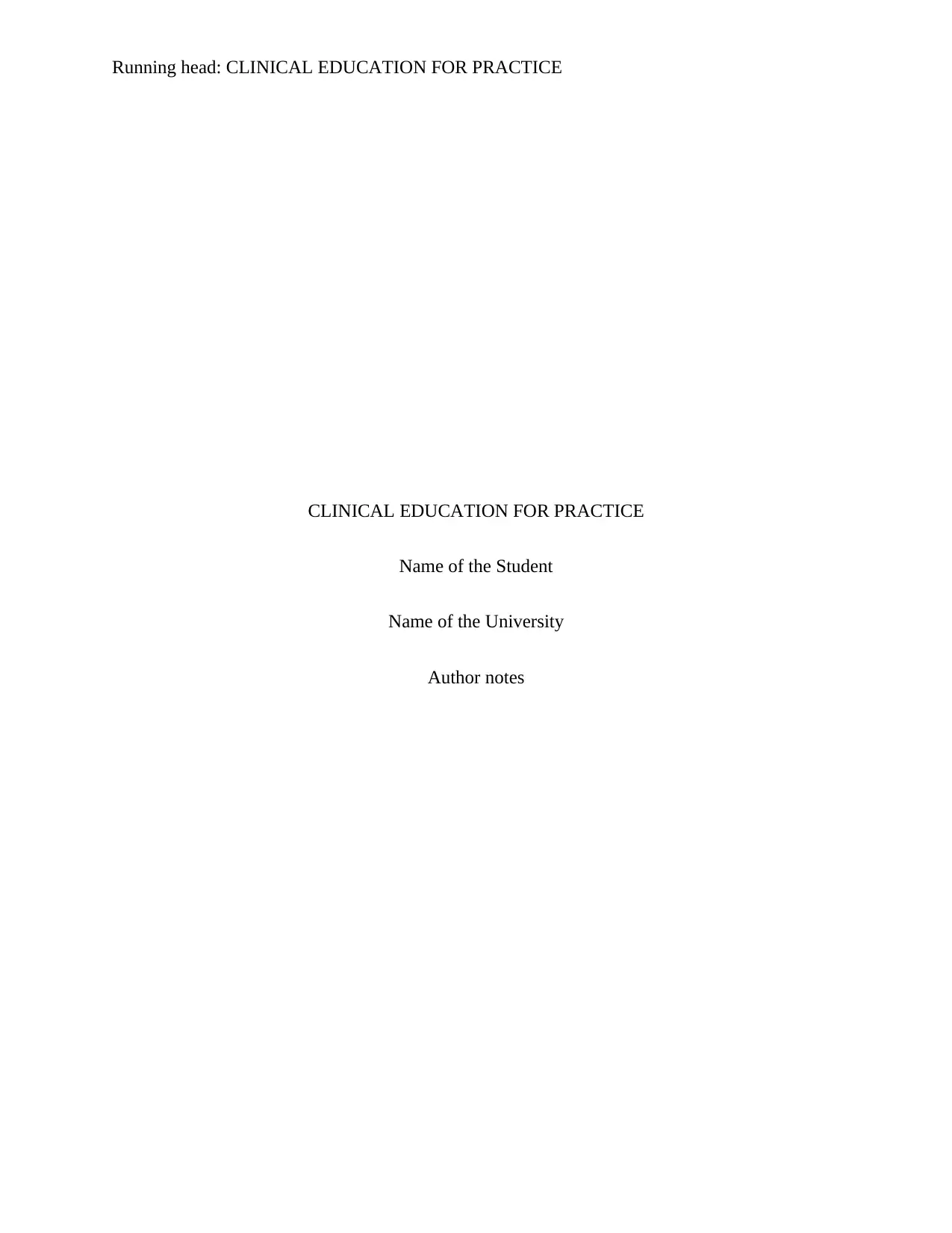
Running head: CLINICAL EDUCATION FOR PRACTICE
CLINICAL EDUCATION FOR PRACTICE
Name of the Student
Name of the University
Author notes
CLINICAL EDUCATION FOR PRACTICE
Name of the Student
Name of the University
Author notes
Paraphrase This Document
Need a fresh take? Get an instant paraphrase of this document with our AI Paraphraser
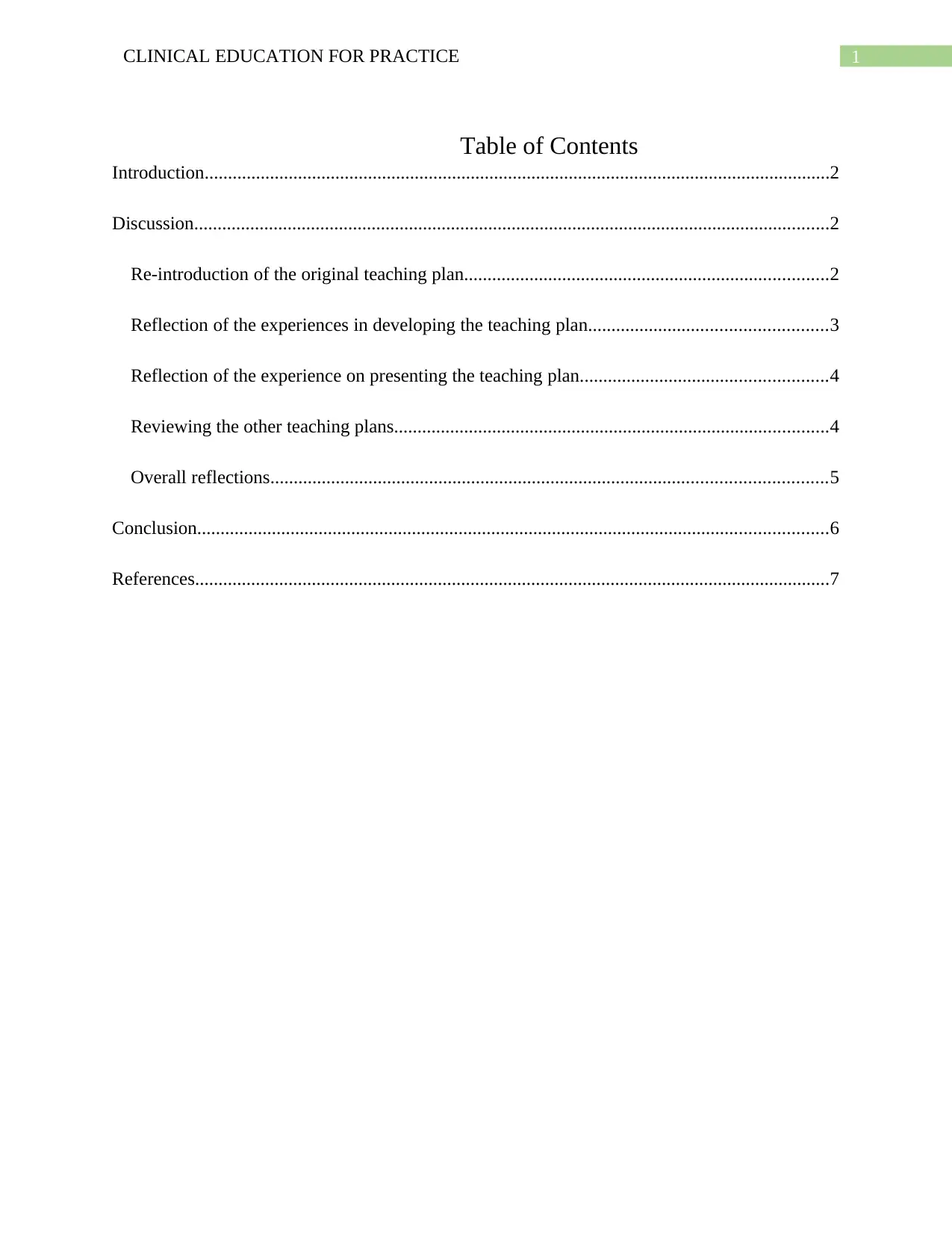
1CLINICAL EDUCATION FOR PRACTICE
Table of Contents
Introduction......................................................................................................................................2
Discussion........................................................................................................................................2
Re-introduction of the original teaching plan..............................................................................2
Reflection of the experiences in developing the teaching plan...................................................3
Reflection of the experience on presenting the teaching plan.....................................................4
Reviewing the other teaching plans.............................................................................................4
Overall reflections.......................................................................................................................5
Conclusion.......................................................................................................................................6
References........................................................................................................................................7
Table of Contents
Introduction......................................................................................................................................2
Discussion........................................................................................................................................2
Re-introduction of the original teaching plan..............................................................................2
Reflection of the experiences in developing the teaching plan...................................................3
Reflection of the experience on presenting the teaching plan.....................................................4
Reviewing the other teaching plans.............................................................................................4
Overall reflections.......................................................................................................................5
Conclusion.......................................................................................................................................6
References........................................................................................................................................7
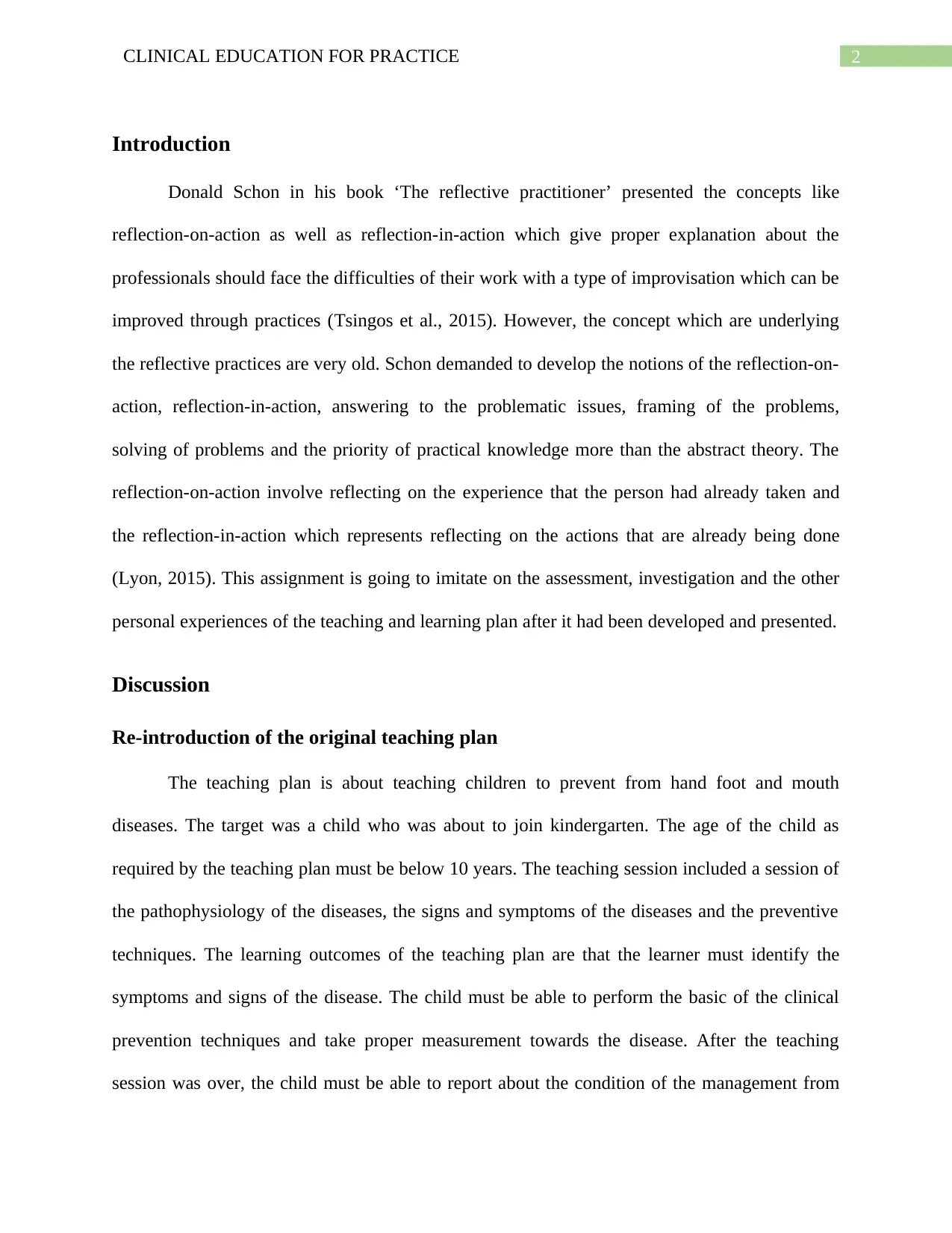
2CLINICAL EDUCATION FOR PRACTICE
Introduction
Donald Schon in his book ‘The reflective practitioner’ presented the concepts like
reflection-on-action as well as reflection-in-action which give proper explanation about the
professionals should face the difficulties of their work with a type of improvisation which can be
improved through practices (Tsingos et al., 2015). However, the concept which are underlying
the reflective practices are very old. Schon demanded to develop the notions of the reflection-on-
action, reflection-in-action, answering to the problematic issues, framing of the problems,
solving of problems and the priority of practical knowledge more than the abstract theory. The
reflection-on-action involve reflecting on the experience that the person had already taken and
the reflection-in-action which represents reflecting on the actions that are already being done
(Lyon, 2015). This assignment is going to imitate on the assessment, investigation and the other
personal experiences of the teaching and learning plan after it had been developed and presented.
Discussion
Re-introduction of the original teaching plan
The teaching plan is about teaching children to prevent from hand foot and mouth
diseases. The target was a child who was about to join kindergarten. The age of the child as
required by the teaching plan must be below 10 years. The teaching session included a session of
the pathophysiology of the diseases, the signs and symptoms of the diseases and the preventive
techniques. The learning outcomes of the teaching plan are that the learner must identify the
symptoms and signs of the disease. The child must be able to perform the basic of the clinical
prevention techniques and take proper measurement towards the disease. After the teaching
session was over, the child must be able to report about the condition of the management from
Introduction
Donald Schon in his book ‘The reflective practitioner’ presented the concepts like
reflection-on-action as well as reflection-in-action which give proper explanation about the
professionals should face the difficulties of their work with a type of improvisation which can be
improved through practices (Tsingos et al., 2015). However, the concept which are underlying
the reflective practices are very old. Schon demanded to develop the notions of the reflection-on-
action, reflection-in-action, answering to the problematic issues, framing of the problems,
solving of problems and the priority of practical knowledge more than the abstract theory. The
reflection-on-action involve reflecting on the experience that the person had already taken and
the reflection-in-action which represents reflecting on the actions that are already being done
(Lyon, 2015). This assignment is going to imitate on the assessment, investigation and the other
personal experiences of the teaching and learning plan after it had been developed and presented.
Discussion
Re-introduction of the original teaching plan
The teaching plan is about teaching children to prevent from hand foot and mouth
diseases. The target was a child who was about to join kindergarten. The age of the child as
required by the teaching plan must be below 10 years. The teaching session included a session of
the pathophysiology of the diseases, the signs and symptoms of the diseases and the preventive
techniques. The learning outcomes of the teaching plan are that the learner must identify the
symptoms and signs of the disease. The child must be able to perform the basic of the clinical
prevention techniques and take proper measurement towards the disease. After the teaching
session was over, the child must be able to report about the condition of the management from
⊘ This is a preview!⊘
Do you want full access?
Subscribe today to unlock all pages.

Trusted by 1+ million students worldwide
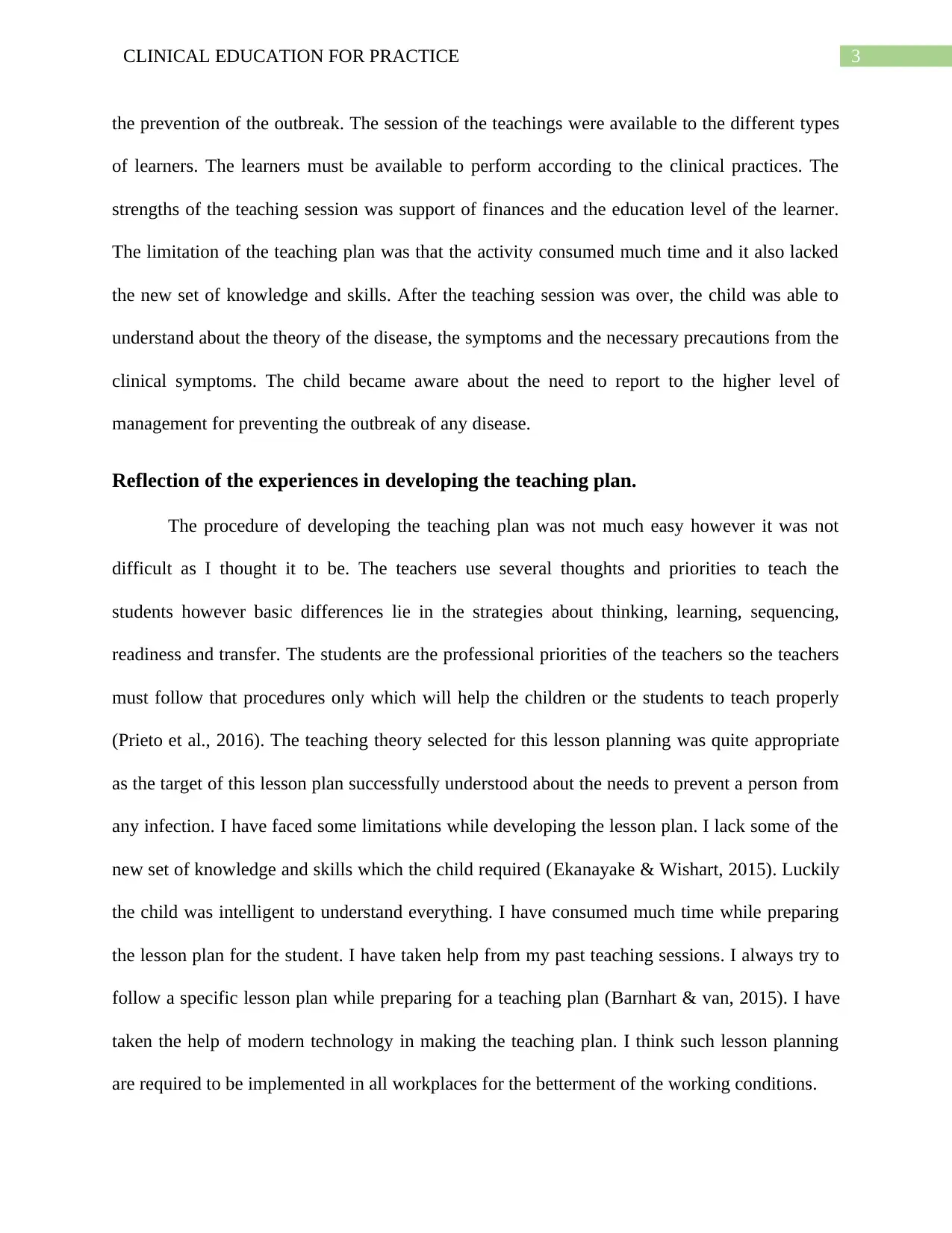
3CLINICAL EDUCATION FOR PRACTICE
the prevention of the outbreak. The session of the teachings were available to the different types
of learners. The learners must be available to perform according to the clinical practices. The
strengths of the teaching session was support of finances and the education level of the learner.
The limitation of the teaching plan was that the activity consumed much time and it also lacked
the new set of knowledge and skills. After the teaching session was over, the child was able to
understand about the theory of the disease, the symptoms and the necessary precautions from the
clinical symptoms. The child became aware about the need to report to the higher level of
management for preventing the outbreak of any disease.
Reflection of the experiences in developing the teaching plan.
The procedure of developing the teaching plan was not much easy however it was not
difficult as I thought it to be. The teachers use several thoughts and priorities to teach the
students however basic differences lie in the strategies about thinking, learning, sequencing,
readiness and transfer. The students are the professional priorities of the teachers so the teachers
must follow that procedures only which will help the children or the students to teach properly
(Prieto et al., 2016). The teaching theory selected for this lesson planning was quite appropriate
as the target of this lesson plan successfully understood about the needs to prevent a person from
any infection. I have faced some limitations while developing the lesson plan. I lack some of the
new set of knowledge and skills which the child required (Ekanayake & Wishart, 2015). Luckily
the child was intelligent to understand everything. I have consumed much time while preparing
the lesson plan for the student. I have taken help from my past teaching sessions. I always try to
follow a specific lesson plan while preparing for a teaching plan (Barnhart & van, 2015). I have
taken the help of modern technology in making the teaching plan. I think such lesson planning
are required to be implemented in all workplaces for the betterment of the working conditions.
the prevention of the outbreak. The session of the teachings were available to the different types
of learners. The learners must be available to perform according to the clinical practices. The
strengths of the teaching session was support of finances and the education level of the learner.
The limitation of the teaching plan was that the activity consumed much time and it also lacked
the new set of knowledge and skills. After the teaching session was over, the child was able to
understand about the theory of the disease, the symptoms and the necessary precautions from the
clinical symptoms. The child became aware about the need to report to the higher level of
management for preventing the outbreak of any disease.
Reflection of the experiences in developing the teaching plan.
The procedure of developing the teaching plan was not much easy however it was not
difficult as I thought it to be. The teachers use several thoughts and priorities to teach the
students however basic differences lie in the strategies about thinking, learning, sequencing,
readiness and transfer. The students are the professional priorities of the teachers so the teachers
must follow that procedures only which will help the children or the students to teach properly
(Prieto et al., 2016). The teaching theory selected for this lesson planning was quite appropriate
as the target of this lesson plan successfully understood about the needs to prevent a person from
any infection. I have faced some limitations while developing the lesson plan. I lack some of the
new set of knowledge and skills which the child required (Ekanayake & Wishart, 2015). Luckily
the child was intelligent to understand everything. I have consumed much time while preparing
the lesson plan for the student. I have taken help from my past teaching sessions. I always try to
follow a specific lesson plan while preparing for a teaching plan (Barnhart & van, 2015). I have
taken the help of modern technology in making the teaching plan. I think such lesson planning
are required to be implemented in all workplaces for the betterment of the working conditions.
Paraphrase This Document
Need a fresh take? Get an instant paraphrase of this document with our AI Paraphraser
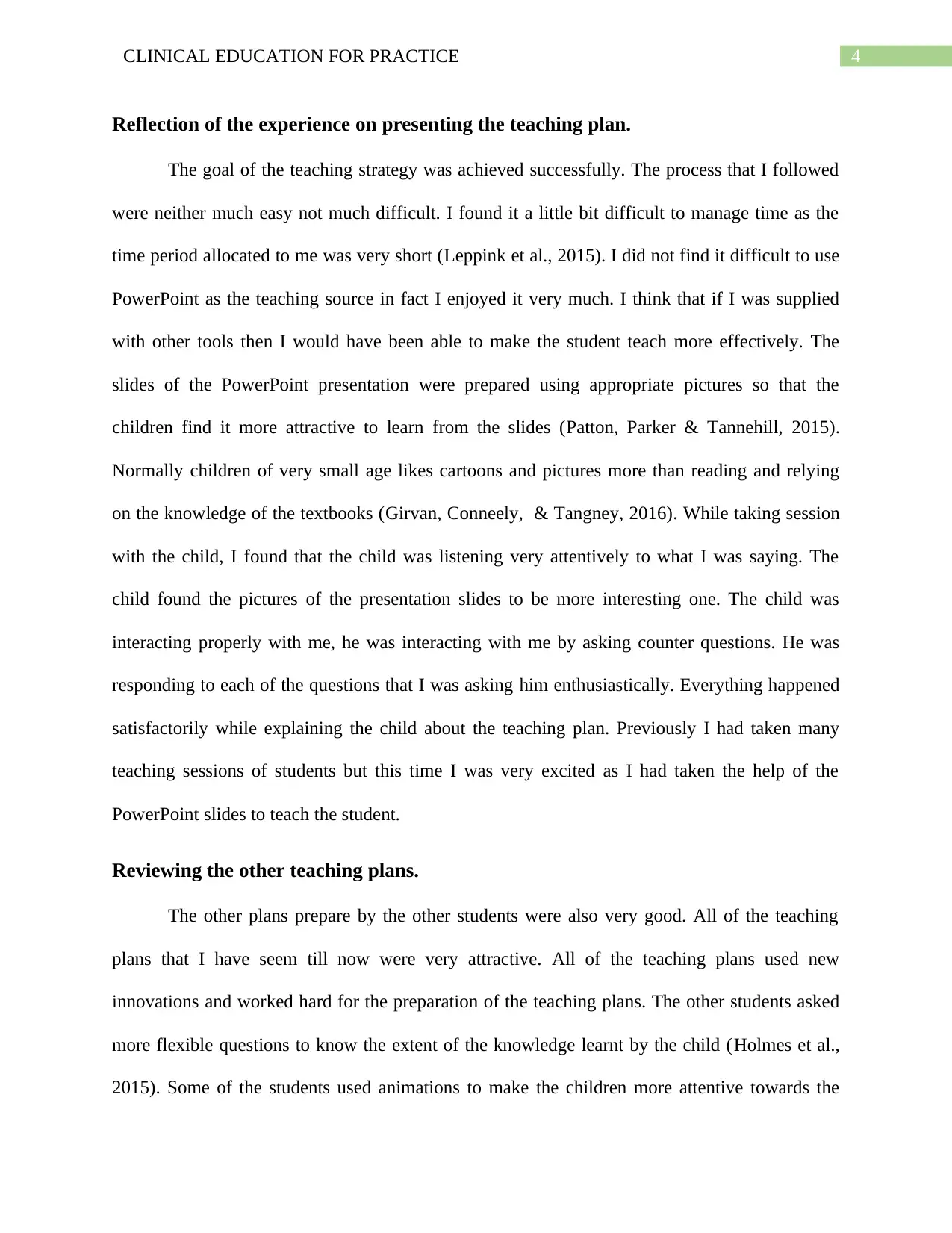
4CLINICAL EDUCATION FOR PRACTICE
Reflection of the experience on presenting the teaching plan.
The goal of the teaching strategy was achieved successfully. The process that I followed
were neither much easy not much difficult. I found it a little bit difficult to manage time as the
time period allocated to me was very short (Leppink et al., 2015). I did not find it difficult to use
PowerPoint as the teaching source in fact I enjoyed it very much. I think that if I was supplied
with other tools then I would have been able to make the student teach more effectively. The
slides of the PowerPoint presentation were prepared using appropriate pictures so that the
children find it more attractive to learn from the slides (Patton, Parker & Tannehill, 2015).
Normally children of very small age likes cartoons and pictures more than reading and relying
on the knowledge of the textbooks (Girvan, Conneely, & Tangney, 2016). While taking session
with the child, I found that the child was listening very attentively to what I was saying. The
child found the pictures of the presentation slides to be more interesting one. The child was
interacting properly with me, he was interacting with me by asking counter questions. He was
responding to each of the questions that I was asking him enthusiastically. Everything happened
satisfactorily while explaining the child about the teaching plan. Previously I had taken many
teaching sessions of students but this time I was very excited as I had taken the help of the
PowerPoint slides to teach the student.
Reviewing the other teaching plans.
The other plans prepare by the other students were also very good. All of the teaching
plans that I have seem till now were very attractive. All of the teaching plans used new
innovations and worked hard for the preparation of the teaching plans. The other students asked
more flexible questions to know the extent of the knowledge learnt by the child (Holmes et al.,
2015). Some of the students used animations to make the children more attentive towards the
Reflection of the experience on presenting the teaching plan.
The goal of the teaching strategy was achieved successfully. The process that I followed
were neither much easy not much difficult. I found it a little bit difficult to manage time as the
time period allocated to me was very short (Leppink et al., 2015). I did not find it difficult to use
PowerPoint as the teaching source in fact I enjoyed it very much. I think that if I was supplied
with other tools then I would have been able to make the student teach more effectively. The
slides of the PowerPoint presentation were prepared using appropriate pictures so that the
children find it more attractive to learn from the slides (Patton, Parker & Tannehill, 2015).
Normally children of very small age likes cartoons and pictures more than reading and relying
on the knowledge of the textbooks (Girvan, Conneely, & Tangney, 2016). While taking session
with the child, I found that the child was listening very attentively to what I was saying. The
child found the pictures of the presentation slides to be more interesting one. The child was
interacting properly with me, he was interacting with me by asking counter questions. He was
responding to each of the questions that I was asking him enthusiastically. Everything happened
satisfactorily while explaining the child about the teaching plan. Previously I had taken many
teaching sessions of students but this time I was very excited as I had taken the help of the
PowerPoint slides to teach the student.
Reviewing the other teaching plans.
The other plans prepare by the other students were also very good. All of the teaching
plans that I have seem till now were very attractive. All of the teaching plans used new
innovations and worked hard for the preparation of the teaching plans. The other students asked
more flexible questions to know the extent of the knowledge learnt by the child (Holmes et al.,
2015). Some of the students used animations to make the children more attentive towards the
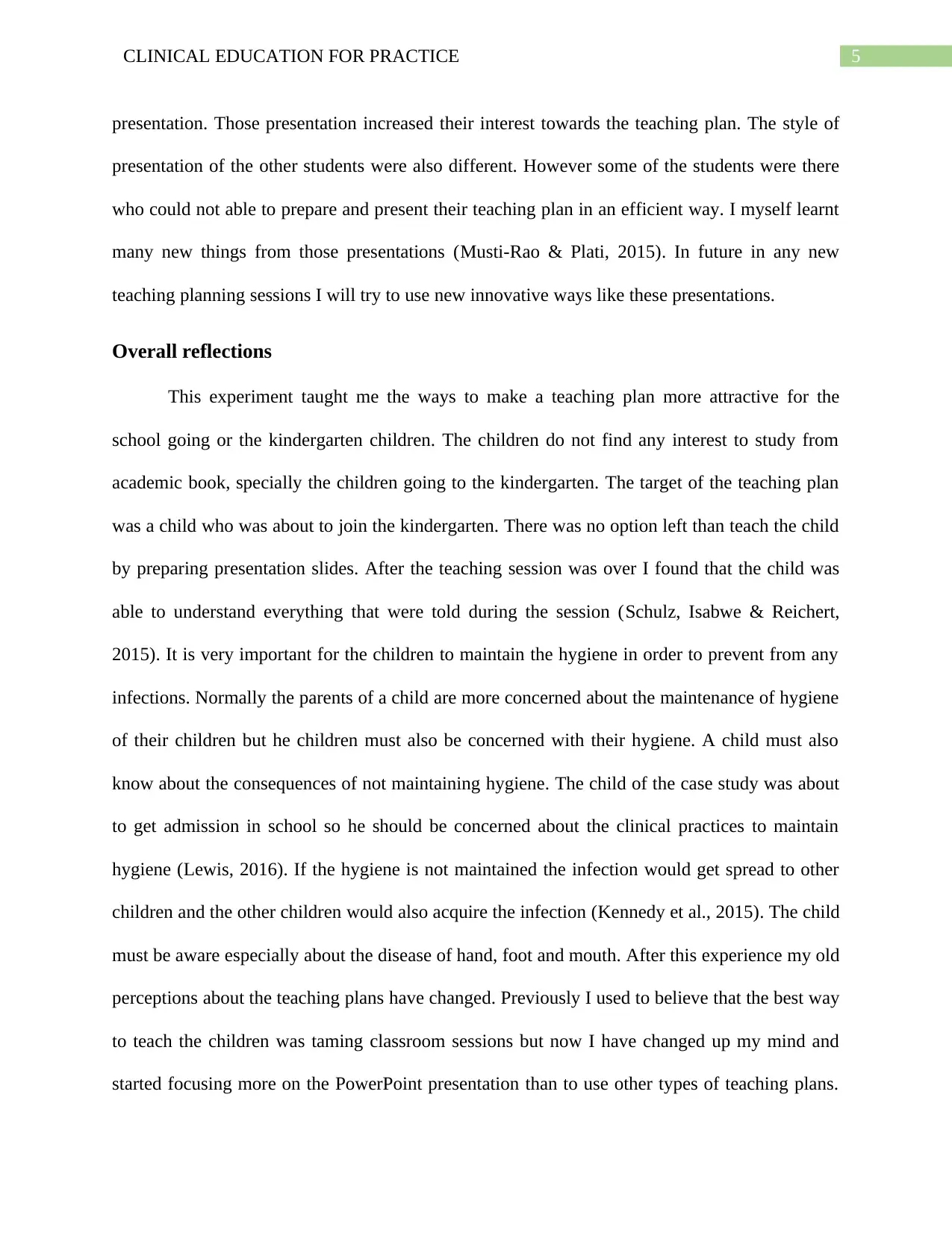
5CLINICAL EDUCATION FOR PRACTICE
presentation. Those presentation increased their interest towards the teaching plan. The style of
presentation of the other students were also different. However some of the students were there
who could not able to prepare and present their teaching plan in an efficient way. I myself learnt
many new things from those presentations (Musti-Rao & Plati, 2015). In future in any new
teaching planning sessions I will try to use new innovative ways like these presentations.
Overall reflections
This experiment taught me the ways to make a teaching plan more attractive for the
school going or the kindergarten children. The children do not find any interest to study from
academic book, specially the children going to the kindergarten. The target of the teaching plan
was a child who was about to join the kindergarten. There was no option left than teach the child
by preparing presentation slides. After the teaching session was over I found that the child was
able to understand everything that were told during the session (Schulz, Isabwe & Reichert,
2015). It is very important for the children to maintain the hygiene in order to prevent from any
infections. Normally the parents of a child are more concerned about the maintenance of hygiene
of their children but he children must also be concerned with their hygiene. A child must also
know about the consequences of not maintaining hygiene. The child of the case study was about
to get admission in school so he should be concerned about the clinical practices to maintain
hygiene (Lewis, 2016). If the hygiene is not maintained the infection would get spread to other
children and the other children would also acquire the infection (Kennedy et al., 2015). The child
must be aware especially about the disease of hand, foot and mouth. After this experience my old
perceptions about the teaching plans have changed. Previously I used to believe that the best way
to teach the children was taming classroom sessions but now I have changed up my mind and
started focusing more on the PowerPoint presentation than to use other types of teaching plans.
presentation. Those presentation increased their interest towards the teaching plan. The style of
presentation of the other students were also different. However some of the students were there
who could not able to prepare and present their teaching plan in an efficient way. I myself learnt
many new things from those presentations (Musti-Rao & Plati, 2015). In future in any new
teaching planning sessions I will try to use new innovative ways like these presentations.
Overall reflections
This experiment taught me the ways to make a teaching plan more attractive for the
school going or the kindergarten children. The children do not find any interest to study from
academic book, specially the children going to the kindergarten. The target of the teaching plan
was a child who was about to join the kindergarten. There was no option left than teach the child
by preparing presentation slides. After the teaching session was over I found that the child was
able to understand everything that were told during the session (Schulz, Isabwe & Reichert,
2015). It is very important for the children to maintain the hygiene in order to prevent from any
infections. Normally the parents of a child are more concerned about the maintenance of hygiene
of their children but he children must also be concerned with their hygiene. A child must also
know about the consequences of not maintaining hygiene. The child of the case study was about
to get admission in school so he should be concerned about the clinical practices to maintain
hygiene (Lewis, 2016). If the hygiene is not maintained the infection would get spread to other
children and the other children would also acquire the infection (Kennedy et al., 2015). The child
must be aware especially about the disease of hand, foot and mouth. After this experience my old
perceptions about the teaching plans have changed. Previously I used to believe that the best way
to teach the children was taming classroom sessions but now I have changed up my mind and
started focusing more on the PowerPoint presentation than to use other types of teaching plans.
⊘ This is a preview!⊘
Do you want full access?
Subscribe today to unlock all pages.

Trusted by 1+ million students worldwide
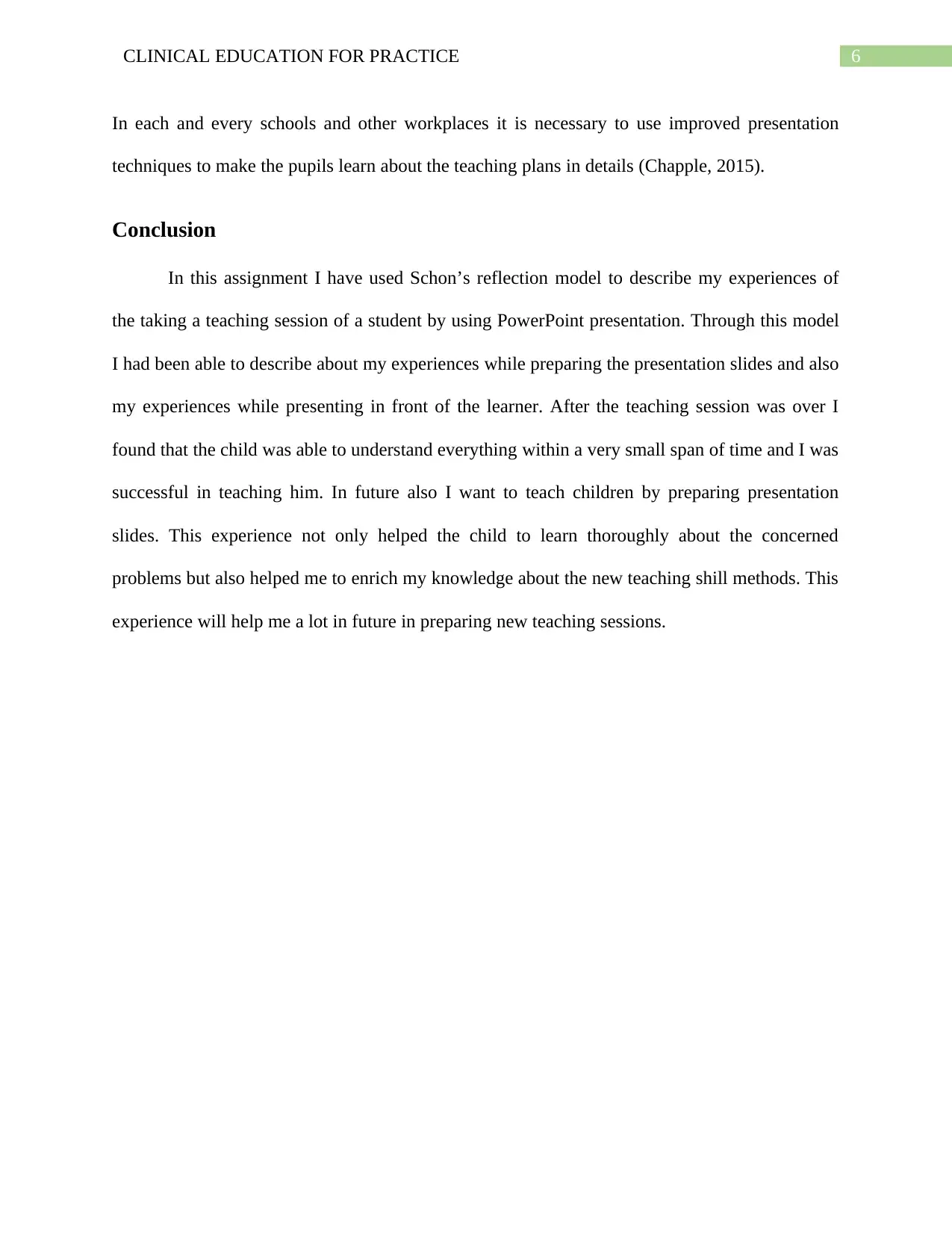
6CLINICAL EDUCATION FOR PRACTICE
In each and every schools and other workplaces it is necessary to use improved presentation
techniques to make the pupils learn about the teaching plans in details (Chapple, 2015).
Conclusion
In this assignment I have used Schon’s reflection model to describe my experiences of
the taking a teaching session of a student by using PowerPoint presentation. Through this model
I had been able to describe about my experiences while preparing the presentation slides and also
my experiences while presenting in front of the learner. After the teaching session was over I
found that the child was able to understand everything within a very small span of time and I was
successful in teaching him. In future also I want to teach children by preparing presentation
slides. This experience not only helped the child to learn thoroughly about the concerned
problems but also helped me to enrich my knowledge about the new teaching shill methods. This
experience will help me a lot in future in preparing new teaching sessions.
In each and every schools and other workplaces it is necessary to use improved presentation
techniques to make the pupils learn about the teaching plans in details (Chapple, 2015).
Conclusion
In this assignment I have used Schon’s reflection model to describe my experiences of
the taking a teaching session of a student by using PowerPoint presentation. Through this model
I had been able to describe about my experiences while preparing the presentation slides and also
my experiences while presenting in front of the learner. After the teaching session was over I
found that the child was able to understand everything within a very small span of time and I was
successful in teaching him. In future also I want to teach children by preparing presentation
slides. This experience not only helped the child to learn thoroughly about the concerned
problems but also helped me to enrich my knowledge about the new teaching shill methods. This
experience will help me a lot in future in preparing new teaching sessions.
Paraphrase This Document
Need a fresh take? Get an instant paraphrase of this document with our AI Paraphraser
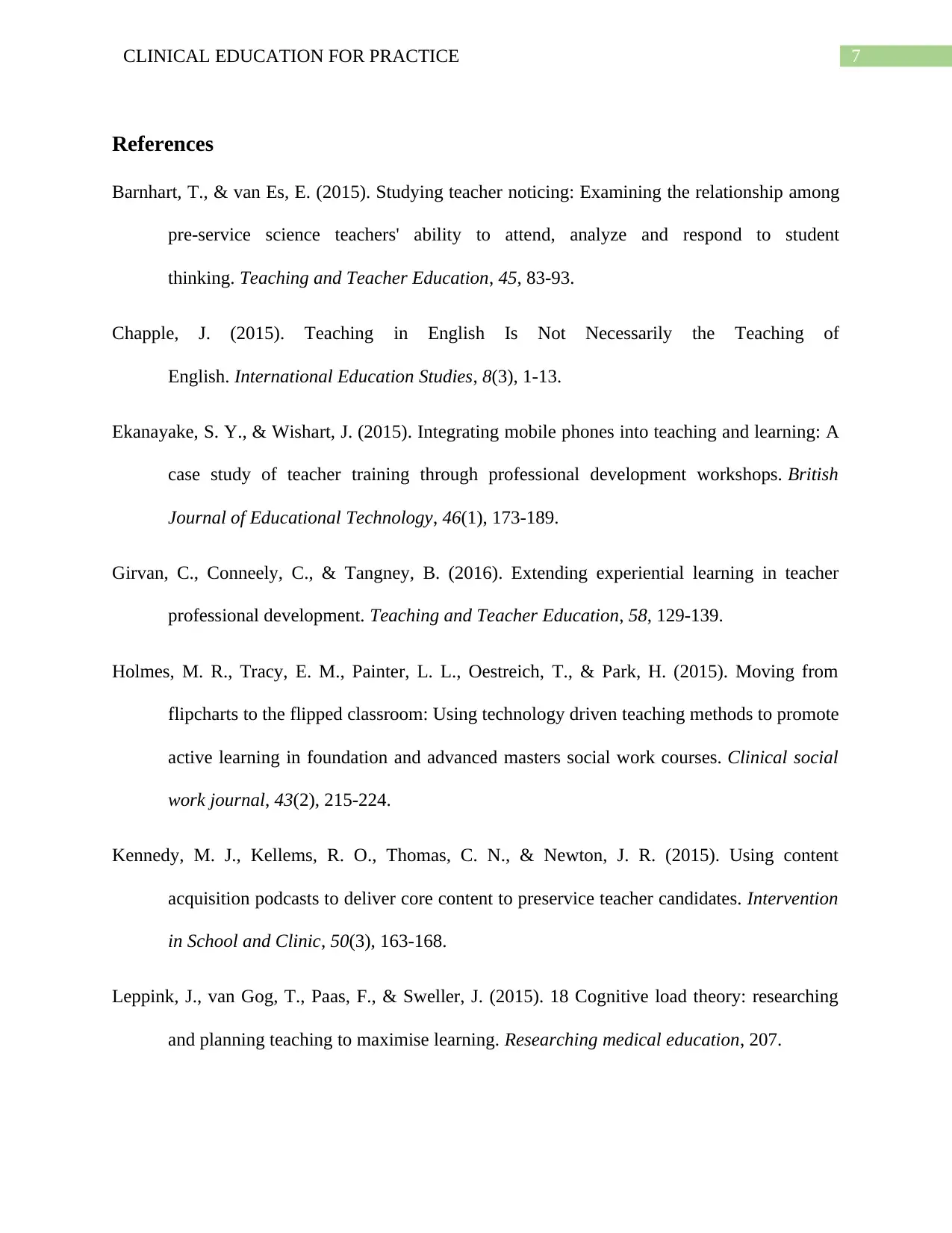
7CLINICAL EDUCATION FOR PRACTICE
References
Barnhart, T., & van Es, E. (2015). Studying teacher noticing: Examining the relationship among
pre-service science teachers' ability to attend, analyze and respond to student
thinking. Teaching and Teacher Education, 45, 83-93.
Chapple, J. (2015). Teaching in English Is Not Necessarily the Teaching of
English. International Education Studies, 8(3), 1-13.
Ekanayake, S. Y., & Wishart, J. (2015). Integrating mobile phones into teaching and learning: A
case study of teacher training through professional development workshops. British
Journal of Educational Technology, 46(1), 173-189.
Girvan, C., Conneely, C., & Tangney, B. (2016). Extending experiential learning in teacher
professional development. Teaching and Teacher Education, 58, 129-139.
Holmes, M. R., Tracy, E. M., Painter, L. L., Oestreich, T., & Park, H. (2015). Moving from
flipcharts to the flipped classroom: Using technology driven teaching methods to promote
active learning in foundation and advanced masters social work courses. Clinical social
work journal, 43(2), 215-224.
Kennedy, M. J., Kellems, R. O., Thomas, C. N., & Newton, J. R. (2015). Using content
acquisition podcasts to deliver core content to preservice teacher candidates. Intervention
in School and Clinic, 50(3), 163-168.
Leppink, J., van Gog, T., Paas, F., & Sweller, J. (2015). 18 Cognitive load theory: researching
and planning teaching to maximise learning. Researching medical education, 207.
References
Barnhart, T., & van Es, E. (2015). Studying teacher noticing: Examining the relationship among
pre-service science teachers' ability to attend, analyze and respond to student
thinking. Teaching and Teacher Education, 45, 83-93.
Chapple, J. (2015). Teaching in English Is Not Necessarily the Teaching of
English. International Education Studies, 8(3), 1-13.
Ekanayake, S. Y., & Wishart, J. (2015). Integrating mobile phones into teaching and learning: A
case study of teacher training through professional development workshops. British
Journal of Educational Technology, 46(1), 173-189.
Girvan, C., Conneely, C., & Tangney, B. (2016). Extending experiential learning in teacher
professional development. Teaching and Teacher Education, 58, 129-139.
Holmes, M. R., Tracy, E. M., Painter, L. L., Oestreich, T., & Park, H. (2015). Moving from
flipcharts to the flipped classroom: Using technology driven teaching methods to promote
active learning in foundation and advanced masters social work courses. Clinical social
work journal, 43(2), 215-224.
Kennedy, M. J., Kellems, R. O., Thomas, C. N., & Newton, J. R. (2015). Using content
acquisition podcasts to deliver core content to preservice teacher candidates. Intervention
in School and Clinic, 50(3), 163-168.
Leppink, J., van Gog, T., Paas, F., & Sweller, J. (2015). 18 Cognitive load theory: researching
and planning teaching to maximise learning. Researching medical education, 207.
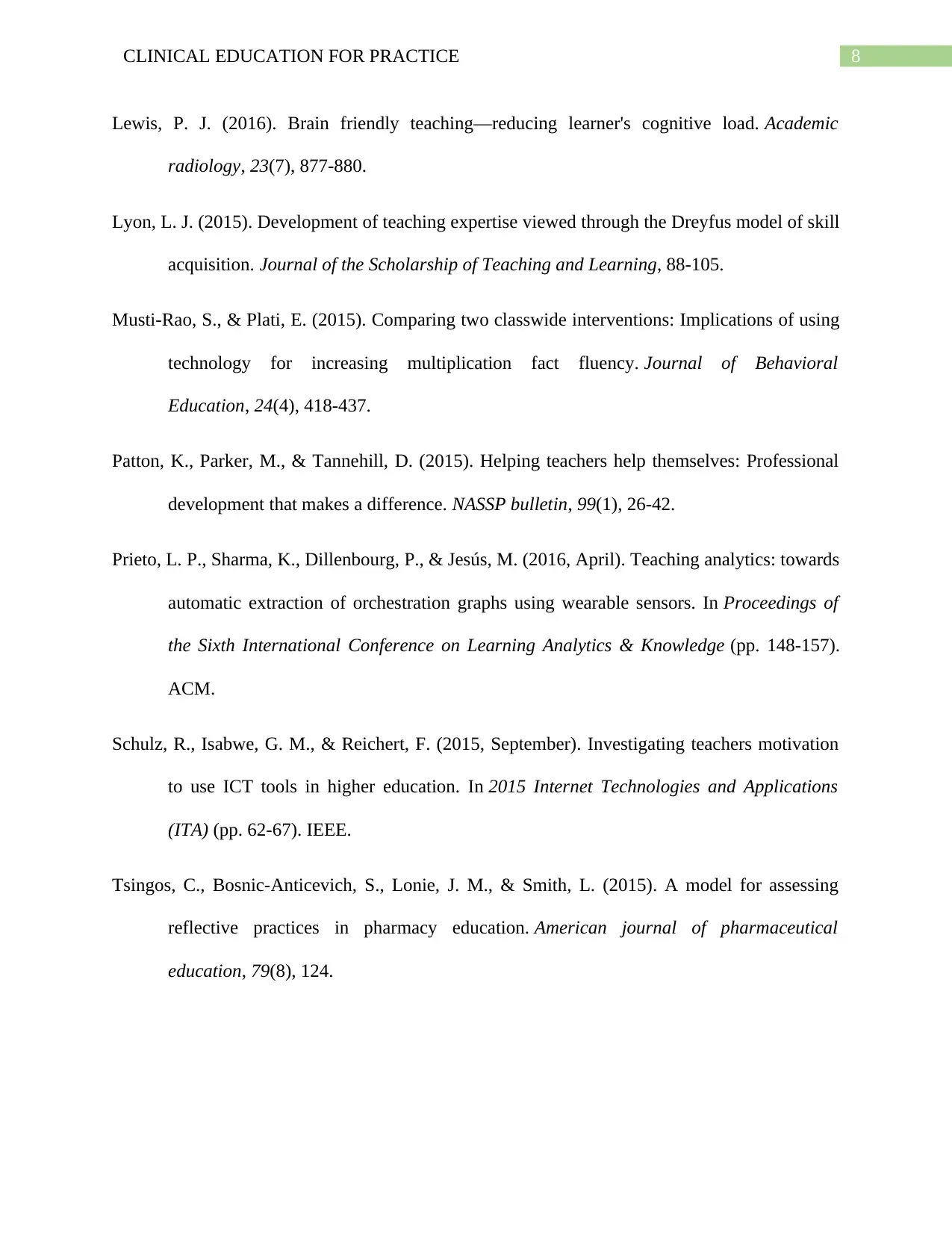
8CLINICAL EDUCATION FOR PRACTICE
Lewis, P. J. (2016). Brain friendly teaching—reducing learner's cognitive load. Academic
radiology, 23(7), 877-880.
Lyon, L. J. (2015). Development of teaching expertise viewed through the Dreyfus model of skill
acquisition. Journal of the Scholarship of Teaching and Learning, 88-105.
Musti-Rao, S., & Plati, E. (2015). Comparing two classwide interventions: Implications of using
technology for increasing multiplication fact fluency. Journal of Behavioral
Education, 24(4), 418-437.
Patton, K., Parker, M., & Tannehill, D. (2015). Helping teachers help themselves: Professional
development that makes a difference. NASSP bulletin, 99(1), 26-42.
Prieto, L. P., Sharma, K., Dillenbourg, P., & Jesús, M. (2016, April). Teaching analytics: towards
automatic extraction of orchestration graphs using wearable sensors. In Proceedings of
the Sixth International Conference on Learning Analytics & Knowledge (pp. 148-157).
ACM.
Schulz, R., Isabwe, G. M., & Reichert, F. (2015, September). Investigating teachers motivation
to use ICT tools in higher education. In 2015 Internet Technologies and Applications
(ITA) (pp. 62-67). IEEE.
Tsingos, C., Bosnic-Anticevich, S., Lonie, J. M., & Smith, L. (2015). A model for assessing
reflective practices in pharmacy education. American journal of pharmaceutical
education, 79(8), 124.
Lewis, P. J. (2016). Brain friendly teaching—reducing learner's cognitive load. Academic
radiology, 23(7), 877-880.
Lyon, L. J. (2015). Development of teaching expertise viewed through the Dreyfus model of skill
acquisition. Journal of the Scholarship of Teaching and Learning, 88-105.
Musti-Rao, S., & Plati, E. (2015). Comparing two classwide interventions: Implications of using
technology for increasing multiplication fact fluency. Journal of Behavioral
Education, 24(4), 418-437.
Patton, K., Parker, M., & Tannehill, D. (2015). Helping teachers help themselves: Professional
development that makes a difference. NASSP bulletin, 99(1), 26-42.
Prieto, L. P., Sharma, K., Dillenbourg, P., & Jesús, M. (2016, April). Teaching analytics: towards
automatic extraction of orchestration graphs using wearable sensors. In Proceedings of
the Sixth International Conference on Learning Analytics & Knowledge (pp. 148-157).
ACM.
Schulz, R., Isabwe, G. M., & Reichert, F. (2015, September). Investigating teachers motivation
to use ICT tools in higher education. In 2015 Internet Technologies and Applications
(ITA) (pp. 62-67). IEEE.
Tsingos, C., Bosnic-Anticevich, S., Lonie, J. M., & Smith, L. (2015). A model for assessing
reflective practices in pharmacy education. American journal of pharmaceutical
education, 79(8), 124.
⊘ This is a preview!⊘
Do you want full access?
Subscribe today to unlock all pages.

Trusted by 1+ million students worldwide
1 out of 9
Related Documents
Your All-in-One AI-Powered Toolkit for Academic Success.
+13062052269
info@desklib.com
Available 24*7 on WhatsApp / Email
![[object Object]](/_next/static/media/star-bottom.7253800d.svg)
Unlock your academic potential
Copyright © 2020–2025 A2Z Services. All Rights Reserved. Developed and managed by ZUCOL.





